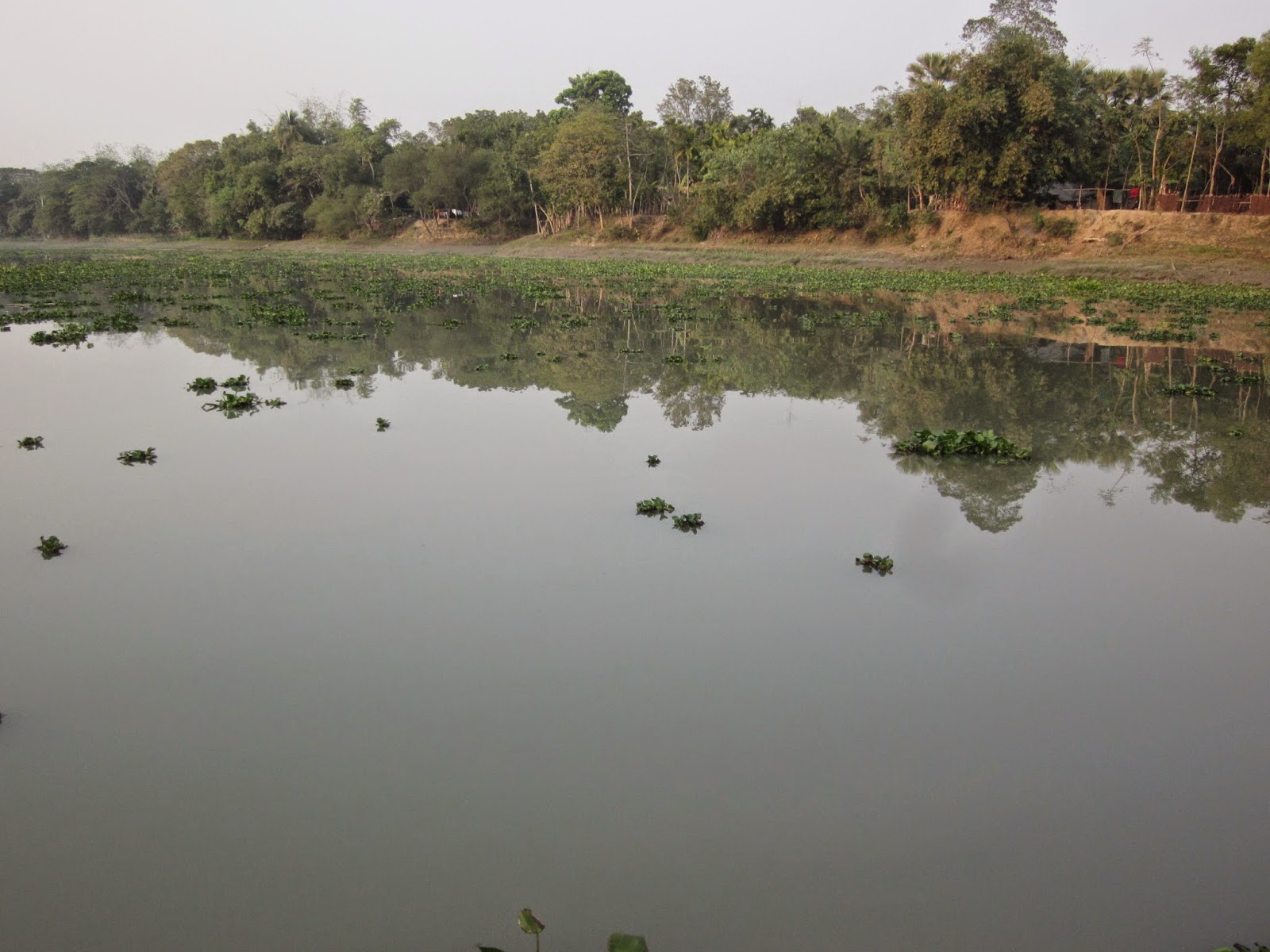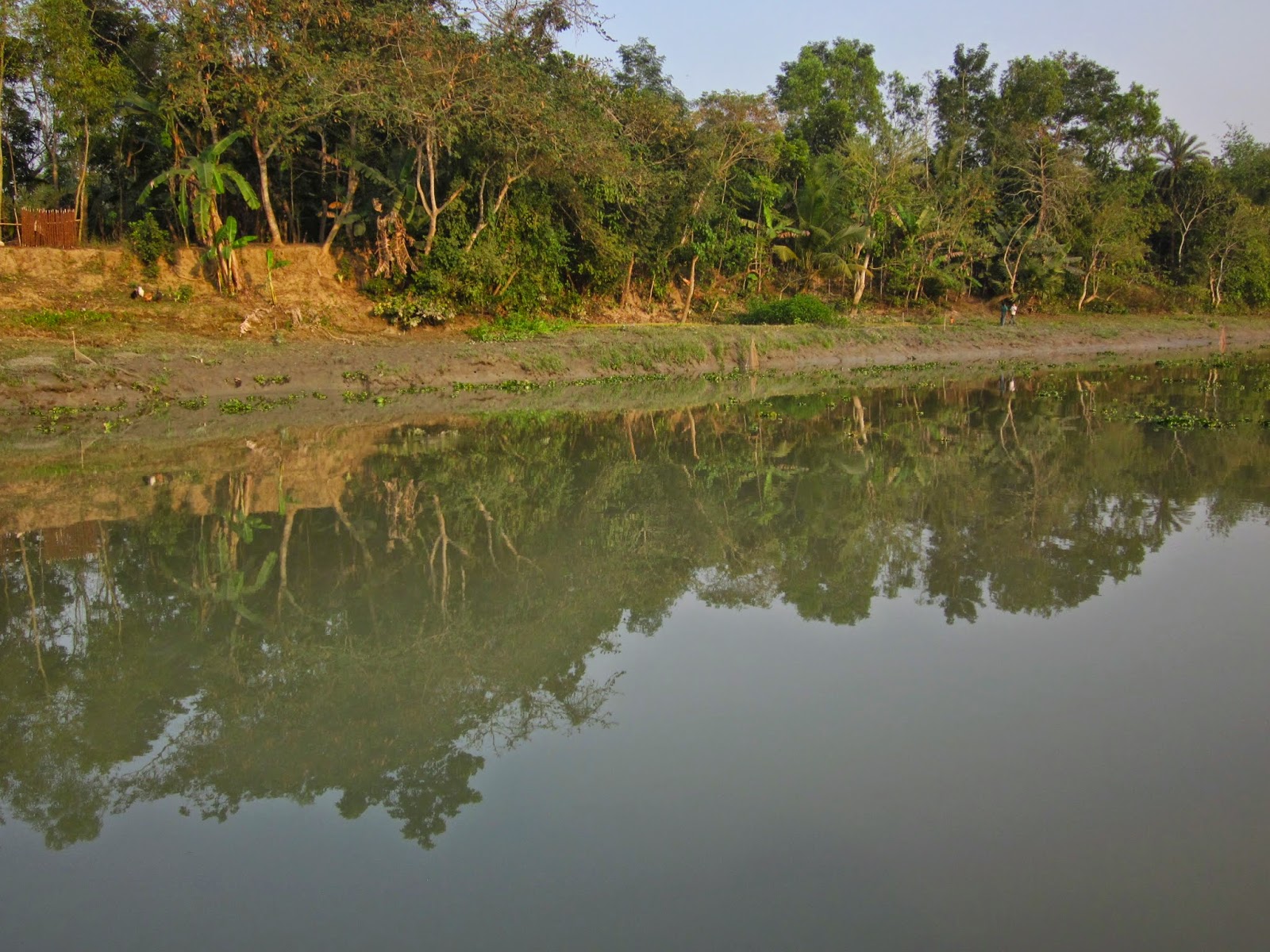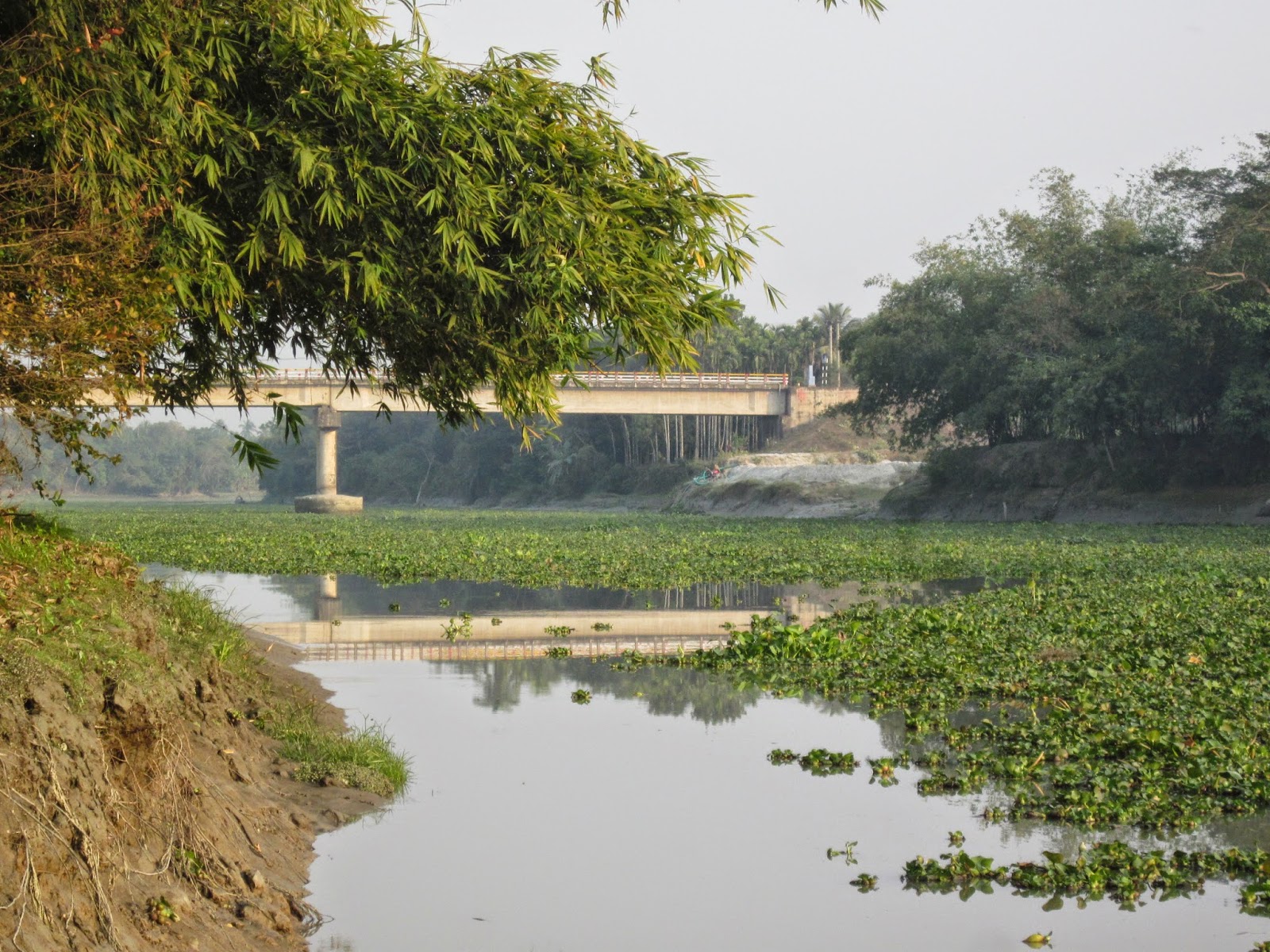 |
| Sunset on the Chitra. |
The ceiling is sagging. In thatch,
painted silver, it’s a ceiling of ripples and waves. There are holes in it,
possibly gnawed into the design by an artisan mouse, possibly the one I
disturbed earlier as it ran up the electric cord beside the bed. I’m on
haunches, typing, trying to understand how to write a river. I wonder how to
find myself in it – contemplating the Chitra.
 |
| Water hyacinth in the Chitra. |
On the afternoon I spent with her, she’d
painted trees in the water in grey silhouette. There were long and longer
canopies of various species, and the high and higher palm crowns among them had
their randomness replicated in the reflection, frond by frond. Despite the
undeniable beauty of the water forest it looked an awkward arrangement. It was as
a poorly planned team photograph with tall and short players posing wherever
they wished.
 |
| The Chitra River, Narail. |
Was the Chitra drawn to the lack of
symmetry to be found in reflected trees and, equally, in human lives? Patterns
of neat squares and lines – they are not more than a foolhardy attempt to order
ourselves as we might like to think we are. In the Chitra was the randomness in
the template of humanity in actuality.
As once I moved about the nouka boat taking photographs of every
aspect of that river I now move about the room driven by thoughts and words:
sitting spread out on the polished concrete floor and typing, then standing,
then pausing to consider where that mouse went. It was brown and looked clean.
But it’s not without cause that I’m thinking to find myself in the Chitra. It’s
what the people of Narail have done.
 |
| The Chitra: river of culture and identity. |
It’s a river that’s been written about,
admired and longed for. The Chitra is culture. The Chitra is identity. Merely
to speak Chitra’s name is to invoke nostalgia in Narail, to see arise in the
local listener that warm, quiet feeling of belonging. Among the myriad
influences that make the human, for Narailis the Chitra is one. It doesn’t take
long for them to mention her.
 |
| Chitra reflections. |
 |
| East bank of the Chitra |
“The Chitra is polluted now,” said the
advocate, “but ten years back it was a pristine river. The water was colourful
and pure. I love Narail – it is in my heart and I can’t imagine living anywhere
else. The Chitra is important.”
“Chitra water is clean and tasty,” it is
written in S.M. Royis Uddin Ahmed’s 2009 book, Laraku Narail. “It was famous across the country.... The Chitra’s
banks were like paintings and people’s houses looked like features in a great
work of art.” True: on that afternoon the east bank was glowing. The sun was
bold, boasting in painting it that way. It was a Baul song, spiritual and
uplifting.
Meanwhile a monitor lizard on Chitra’s
bank up and scuffled away into the bushes, not wishing to be observed. The
bright and the hidden: parts of the river and the human. It can’t be hard for
Narailis to find themselves when contradiction is there.
 |
| Monitor lizard on the bank of the Chitra. |
 |
| Md. Litu Sheikh. |
Yet for Md. Litu Sheikh the Chitra is a
practical affair: he’s spent ten of his twenty-eight years ferrying passengers
the short distance into Roopganj Bazar and home again. They arrive at the
eastern bank with empty artificial-hessian sacks and carry bags. They return
from the western bank burdened with groceries: rice grain, vegetables, clothes,
eggs, books. They stand as a floating crowd, with one or two finding a sitting place;
some hold umbrellas to protect from the sun – all are as mannequins on a street
parade float. The stationary crowd moves smoothly eastwards at the pace of
Sheikh’s oar.
From the Chitra’s waters comes the
ferryman’s modest income that supports his son and daughter but despite the day
to day nature of his river-relation he will admit to the river’s beauty. The Chitra
is the human is Narail – at many levels.
 |
| The water of the Chitra was once renowned for its purity. |
But on that afternoon Sheikh’s nouka wandered up and down instead – with
a group of local journalists I journeyed there. They had taken the opportunity
to retire from the usual chatting and strategising spot under the bokul tree.
They were joking and discussing matters of journalist interest. Video and still
cameras were busy for no real purpose, other than to keep their stock images ready
in case a Chitra-related story came along – illegal dredging or land-filling or
pollution.
We saw people gathered at the stately
ghat which the zamindar landlords built many years ago, some socialising,
others pondering and casting thoughts into the water like skimming stones. We
saw the bridge in the south that not everyone chooses to use: it’s as easy to
take Sheikh’s ferry and join a bus service originating on the eastern side.
Many Narailis must seek to keep a little more Chitra in their lives.
 |
| Boat on the Chitra. |
In the kochuripana, the water hyacinth, the path of the mainstream was
clear. As a great Serengeti herd it moved in unison. There’s the human in that
too I suppose. And for the few who choose to do things differently, they can as
easily detect the current to move against.
Taro plants meanwhile grew in rows along
the shoreline in places, planted by some innovative thinker. They were orderly
and out of place of course. They might represent mankind’s interference with
the natural world, a kind of deterioration brought about by the need for
sustenance.
But it being Narail, taro rows might
better be described as symbols of the strength from the earth, the gift of God
in providing nourishment. That’s how the town’s premiere artist S.M. Sultan would
have described it. He held affection for farmers.
 |
| Bridge to the south of Roopganj Bazar. |
And it was along Chitra’s banks that the
man, affectionately known as Lal Miah, often walked. On the west bank before
the bridge is his boat in yellow and sky blue, displayed for the Chitra’s
viewing, under an awning, outside the museum.
And on the Chitra children still get
about by arranged boat on special days, in mimicry of one of Sultan’s
endeavours. He wanted them to experience the intersection between nature, art
and the human. He wanted they should be inspired and find their better selves.
 |
| Let's take a nouka out on the Chitra. |
Given the indivisibility of Chitra and
Narail it’s initially surprising to notice that the huddle of buildings that is
Roopganj Bazar follow the curious Bangladeshi tradition of facing away from the
river. Yet in Chitra’s case perhaps there’s an element of shame in it. The
buildings must recognise their preference for bustle more than beauty. Facing
the past renown of the clear water Chitra – it’s understandable if they don’t
feel up to it.
 |
| Ferry passengers on the Chitra. |
As the sunset painted a finale, a bright
orange streak across the water; and the nouka turned at last for the Roopganj
ghat, the Chitra contemplation was almost done.
And yet, for a river of a
town-and-district identity, a river in which one may seek to find oneself, the
Chitra’s realm is as easy to get lost in. Anyway, perhaps it’s rather simpler to
find the human in the moving about in a room with a mouse somewhere and a
sagging ceiling overhead, typing into a laptop.
 |
| Md. Litu Sheikh has been a boatman for ten years. |
 |
| Sheikh's nouka and the bridge. |
 |
| The Chitra is Narail. |
 |
| Water hyacinth and Roopganj Bazar. |

touchy writing!!!
ReplyDelete